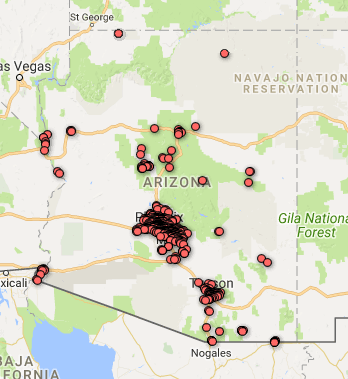Third, we looked through enrollment applications and policies to see if they contained language related to a student’s disciplinary history. We categorized schools as having a violation (V) if they denied enrollment to students who’ve been suspended, long-term suspended or who’ve attended alternative schools. We also categorized schools as having a violation (V) if enrollment was conditioned upon a review of a student’s discipline records. We categorized schools, except alternative schools, as having suppressive language (S) if they asked about a student’s disciplinary history or records and did not provide a disclaimer that this information would not affect enrollment. According to an Arizona Department of Education spokesperson, alternative schools “may ask those questions [about behavioral history] during the enrollment process to better assist how the school operates.”
Fourth, we reviewed enrollment documents to see if they contained any language that could discourage non-English speaking parents and students, such as schools stating they will not accommodate limited English proficient parents and students. We did not find schools that used this type of language. We categorized schools as having suppressive language (S) if their enrollment forms asked generic language questions, such as what language the student speaks at home, without including the Primary Home Language Other Than English (PHLOTE) survey or a similar survey stating this information would be used only to determine whether the students would be assessed for English language proficiency.
Fifth, we looked through enrollment applications and lists of required enrollment materials to see whether they required a Social Security number or citizenship information. We made a note of all the schools that asked students to provide Social Security numbers. We categorized schools as having a violation (V) if they asked parents to provide their Social Security numbers or to provide information or documentation related to their children’s citizenship or immigration status. We categorized schools as having a possible violation (P) if they asked parents to provide a photo ID or if they asked when students, if born in another country, entered and started attending school in the U.S. We categorized schools as having suppressive language (S) if they asked for a student’s birth certificate without offering alternatives documents that can be used to prove a student’s age and identity.
Sixth, we searched for any pre-enrollment requirements for parents or students. We categorized schools as having a violation (V) if enrollment was conditioned upon requirements such as essays, interviews, tours or school visits.
Seventh, we searched for policies requiring parents or family members to volunteer at the school or donate money to the school as a condition for enrollment. We categorized schools as having a violation (V) if they used words such as “expect” or “require” in relation to parent volunteering and donations. When schools asked parents to fill out volunteer commitment forms as part of the enrollment process, we categorized them as having a possible violation (P) because it wasn’t made clear if it was a condition that must be met prior to enrollment.
Eighth, we examined enrollment forms and policies to see whether schools charged fees for activities or items that are an integral component of a student’s education. Specifically, we looked for fees tied to essential course materials like textbooks (C), fees tied to enrollment (E), and fees for activities, like field trips, and school supplies (F). We made a note of all the schools that charged such fees and did not offer to waive fees for families who could not pay for them.
Ninth, we looked for other barriers for enrollment or continued enrollment. Schools were characterized as having a violation (V) if they advised parents that their children should enroll elsewhere if the “environment” was not “appropriate” for a particular student. We also categorized schools as having a violation (V) if they conditioned continued enrollment on academic performance. We categorized schools as having suppressive language (S) if they stated enrolled students have to meet strict academic requirements, such as take AP classes or get all C’s, to move on to the next grade level. We categorized schools as having a violation (V) if they stated a student will be withdrawn if the student has fewer absences than what Arizona law allows. We categorized schools as having a possible violation (P) if they stated a student may be withdrawn, suspended or lose credit for having fewer absences than what Arizona law allows.
We noted when schools did not (N) have a violation. Data was unavailable (U) for 73 schools that do not make their enrollment materials available on the Internet and did not respond to requests for those public records.
If your charter school has an illegal or exclusionary policy, first contact the school’s administration or charter network and ask them to change their policy. If you speak to them over the phone or in person, ask for the individual’s name and be sure to follow up in writing. If they do not change the policy, you should file a complaint with the school’s authorizer, like the Arizona State Board for Charter Schools. Please also inform the ACLU of Arizona of the illegal or exclusionary policies by emailing demandtolearn@acluaz.org.
If you're a school administrator and want to learn more about how you can improve your school's enrollment practices, email demandtolearn@acluaz.org

